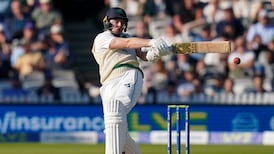If Italian three-quarters’ play fails to evlove then the side will be doomed to one-off, if notable, victories
The condescension is inadvertent, not meant as a calculated slight, but Italy’s rugby team and management must be tired of being patronised when it comes time to talk turkey on an annual basis ahead of the Six Nations Championship.
There is a common vocabulary employed by their opponents to describe the prospect of facing the Italians; commentators share that tone. Italy have a formidable set piece, a powerful scrum that can destabilise, are very physical at the breakdown and aggressive in the collisions.
Words that won’t pepper any discussion on the Azzurri include subtlety, flair and vision.
It’s not so much an image problem just an honest appraisal on the way the Italian rugby team has largely performed in 13 Six Nations tournaments to date. A succession of coaches may have approached the position determined to expand on sterile patterns but quickly realised that they lacked the personnel to do so.
In the last five seasons, Italy have won a single game, in four tournaments – the highlight was a 22-21 victory over France in 2011 – and a whitewash on the other occasion. Scotland are the most frequently ambushed, Wales occasionally susceptible.
In November 2011 the Italian Rugby Federation (FIR) appointed a Frenchman and former coach at Perpignan, Jacques Brunel as head coach. He quickly appreciated that to try and seriously change the national team’s fortunes, they needed to develop a more rounded approach.
Italian pack
The statistics back up that assertion. In the 13 Six Nations tournaments to date, the Italians have managed a less than grand total of 77 tries, three more than Scotland but a whopping 118 tries behind England. By way of comparison France have scored 169, Ireland 167 and Wales 133. Italy do not score enough tries and the majority shareholders in that particular franchise is the pack.
The Italian pack provides the steel backbone but an overreliance on this unit leads to overall vulnerability. England and France have the physique to match the Italian eight, Wales too, while Ireland and Scotland must rely on superior skill sets to offset ferocious pressure in the scrum and at the breakdown. Think of the number of times Irish players have refereed to the bruising nature of matches against Italy.
Italian back play is muscular, based on aggressive running, something to which Brunel has been trying to add variation. Since the days of Diego Dominguez and more latterly Alessandro Troncon the Italians have been searching out a half-back combination that would bring direction and variety behind the scrum. For the most part it’s been a fruitless crusade.
Brunel wants his team to speed up their game and to this end has singled out scrumhalf Edoardo Gori as the man to provide the quicksilver service.
The 22 year old looks a balanced player, with a decent kicking game, quick across the turf and willing to challenge the fringe defence.
Brunel must decide whether Gori’s partner is Treviso team-mate Kris Burton, Luciano Orquera or Alberto di Bernardo.
Tommaso Benvenuti had the hopes of a nation pinned to his broad shoulders as a teenager, cited as the forerunner to a new breed of exciting young backs. He has shown glimpses of his talent in the intervening period on the wing and in the centre, but is reliant on that’s happening closer to the hub of the game to provide an impact.
Giovanbattista Venditti is a physically strong wing, who can also play, in the centre and has a couple of tries in his nine caps while the usual suspects remain in Gonzalo Garcia, Gonzalo Canale, Andrea Masi and Alberto Sgarbi.
One of the sport’s outstanding footballers Sergio Parisse will lead by name and deed, a formidable pack that is underpinned by athleticism and power. Italy beat Tonga in November (tries came from the pack), lost narrowly to a second string Australian side and were well beaten by New Zealand.
They have France, Wales and Ireland at home. Twickenham will hold plenty of fears, Murrayfield none.
Italy will be cussed opponents at home and possibly in Edinburgh but unless their back play evolves the one-off victories will remain a staple diet.
They must also solve the riddle of why they struggle to last the pace competitively over the 80 minutes.
Stopping the Italian pack is a slogan that the Azzurri must change to alter their Six Nations’ fortunes.
Six Nations pointers
They’ve three home matches against France, Wales and Ireland and will expect to be competitive in each one. They’ll fancy their chances in going to Murrayfield. Italy’s back play, their work at halfback and their discipline must get appreciably better; even a marginal improvement will make them tougher to beat.
Piano shifters
Sergio Parisse has been recognised as an outstanding player in global terms which merely emphasises his prodigious ability given that the Italian national team is hardly the ideal platform. The number eight has wonderful skills and is the heartbeat of his team.
Piano players
Eduardo Gori has been charged with injecting some pace and rhythm into the Italian game. It’s all been a bit predictable, one-out runners and slow, laboured decision making. He’ll try and change that philosophy.
Six Nations Squad
Backs: Tommaso Benvenuti (Treviso) Tobias Botes (Treviso) Kristopher Burton (Treviso) Paolo Buso (Zebre) Gonzalo Canale (La Rochelle) Gonzalo Garcia (Zebre) Edoardo Gori (Treviso) Tommaso Iannone (Treviso) Andrea Masi (Wasps) Luke McLean (Treviso) Luciano Orquera (Zebre) Alberto Sgarbi (Treviso) Giovanbattista Venditti (Zebre)
Forwards: Roberto Barbieri (Treviso) Valerio Bernabo (Treviso) Martin Castrogiovanni (Leicester) Lorenzo Cittadini (Treviso) Alberto De Marchi (Treviso) Paul Derbyshire (Treviso) Simone Favaro (Treviso) Joshua Furno (Narbonne) Quintin Geldenhuys (Zebre) Leonardo Ghiraldini (Treviso) Davide Giazzon (Zebre) Andrea Lo Cicero (Racing Metro) Francesco Minto (Treviso) Sergio Parisse (Stade Francais) Antonio Pavanello (Treviso) Michele Rizzo (Treviso) Ratu Manoa Vosawai (Treviso) Alessandro Zanni (Treviso)












